Tulips have always been a darling for their splash of colors in the garden during spring. Planting tulips during the fall is the best investment for spring flowers. And pairing these flowers with other colorful flowering plants will make your garden even more colorful.
Having only tulips may seem monotonous. But pairing the tulips with other contrasting color plants can break that monotony. So, in this article what can you plant with tulips.
In general, tulips can be paired with other flowering plants like Hyacinth, Snowdrops, Allium, Crocuses, Daffodils, etc. You can also pair them with herbs like rosemary, sage, etc. Please select plants with the same requirements as the tulips-full sun, well-drained soil, and occasional dosing.
I have assembled a list of plants you can ideally grow along with the tulips in this article. To fill your garden with distinctive colors, keep reading to know the best tulip companions.
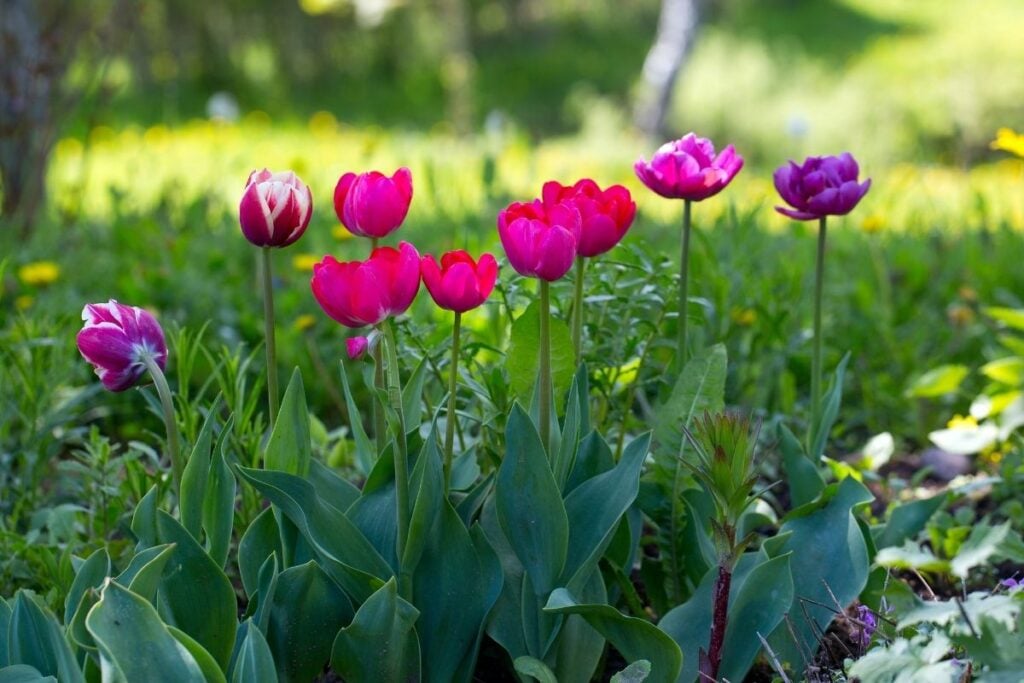
Pairing up plants with tulips
You will get a lot of advantages if you pair up tulips with other plants with the exact requirements:
You can always fill your garden with blooms. You can plant those flowers which bloom before, during, and after the blooming period of tulips.
Spring can be divided into three parts, early spring, mid-spring, and late spring. If you plant spring bulbs that bloom each spring and have less effort, your garden will never fall short of color.
If you love colors, you can play with colors in your garden. For instance, you can plant purple tulips and yellow daffodils or scented blue hyacinths with purple-flamed orange tulips.
You can also arrange the colors, like combining tall and short bright pink tulips with pastel pink hyacinths.
You can create a floral carpet effect by planting tulips with other flowers. For example, you can plant many tulips next to a lot of alliums, daffodils, or crocuses.
These plants, tulips, daffodils, crocuses, hyacinths will help pollinate.
What can I plant with Tulips?
Now let’s talk about the tulip companions.
Forget me not
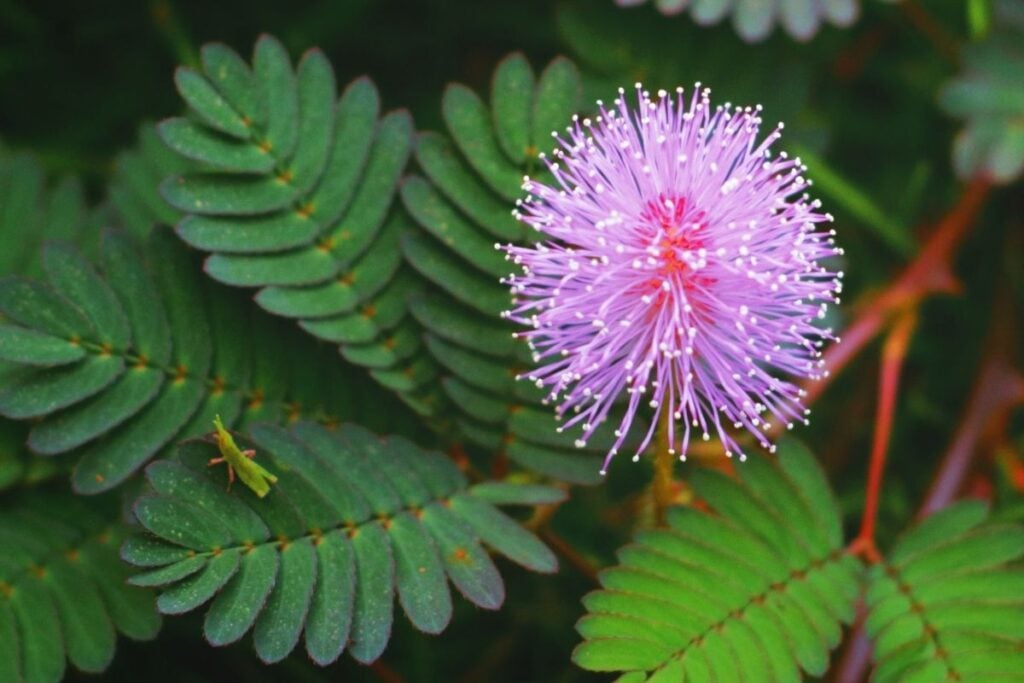
They have bright green leaves holding cloud-shaped small, blue flowers. They grow abundantly under full sun to partial shade.
When grown with tulips, these flowers can create an excellent floral carpet design in your garden.
They require well-drained and fertile soil that remains evenly moist. They enjoy growing in slightly acidic to neutral or slightly alkaline soil.
More or less, their requirements are the same as the tulips. When planted with tulips, they will create an excellent soothing background for the tulips in your garden.
As the Forget-me-not plant is long-lasting, it will keep your garden visually interesting even when the tulips start fading after blooming.
Alliums
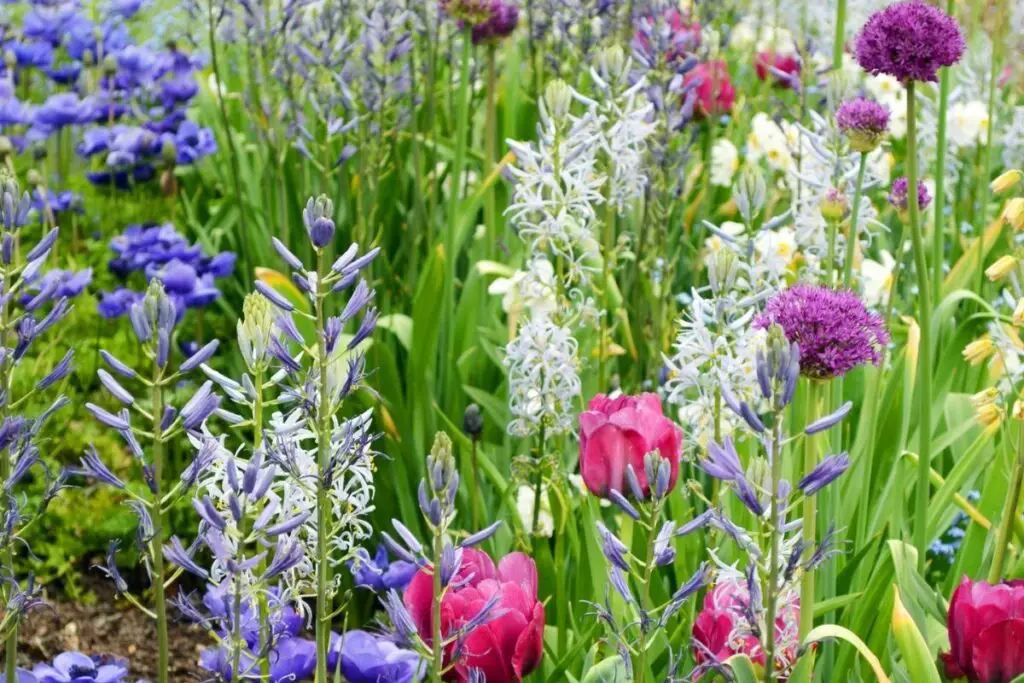
These are the bulb plants, like tulips. Their leaves resemble the size of the tulip foliage. These plants will flower a few weeks after the tulips have done blooming.
Even if the tulip blooms and foliage fades and dies, these plants will have flowers and save your garden from having a bland look. These are satisfying for those gardeners who always enjoy having blooms in the garden.
Alliums will prefer growing under full sun to partial shade. They will bloom in early spring and continue till summer. They require soil that is evenly moist and well-drained.
Adding compost will help them to remain fertile, just like tulips.
You don’t need to put any individual efforts while growing them together.
Looking for gardening supplies? We have tested 100's of products before recommending them to you guys. Check out our best pick below:
| Image | Gardening Supplies | Best Price? |
|---|---|---|
 Top
Top Top
Top | Raised Garden Bed Kit | Check On Amazon |
 | XLUX Soil Moisture Meter, Plant Water Monitor, Soil Hygrometer Sensor for Gardening, Farming, Indoor and Outdoor Plants, No Batteries Required | No Results |
 Top
Top Top
Top | 82 Pcs Garden Tools Set and Extra Succulent Tools Set | Check On Amazon |
 | Joeys Garden Expandable Garden Hose with 8 Function Hose Nozzle, Lightweight Anti-Kink Flexible Garden Hoses, Extra Strength Fabric with Double Latex Core, (50 FT, Black) | No Results |
 Top
Top Top
Top | Dual Chamber Compost Tumbler | Check On Amazon |
 Top
Top Top
Top | Sunnyglade Plant Stakes | Check On Amazon |
 Top
Top Top
Top | Organic Cold Pressed Neem Seed Oil | Check On Amazon |
 Top
Top Top
Top | Mighty Mint Gallon :-Insect and Pest Control Peppermint Oil | Check On Amazon |
 Top
Top Top
Top | Scotts DiseaseEx Lawn Fungicide | Check On Amazon |
 Top
Top Top
Top | Jacks Classic 20-20-20 All Purpose Fertilizer | Check On Amazon |
 Top
Top Top
Top | 30,000 Seeds Pollinator Attracting Wildflower Mixture | Check On Amazon |
 Top
Top Top
Top | Survival Vegetable Seeds Garden Kit-Over 16,000 Seeds | Check On Amazon |
Snowdrop Anenome
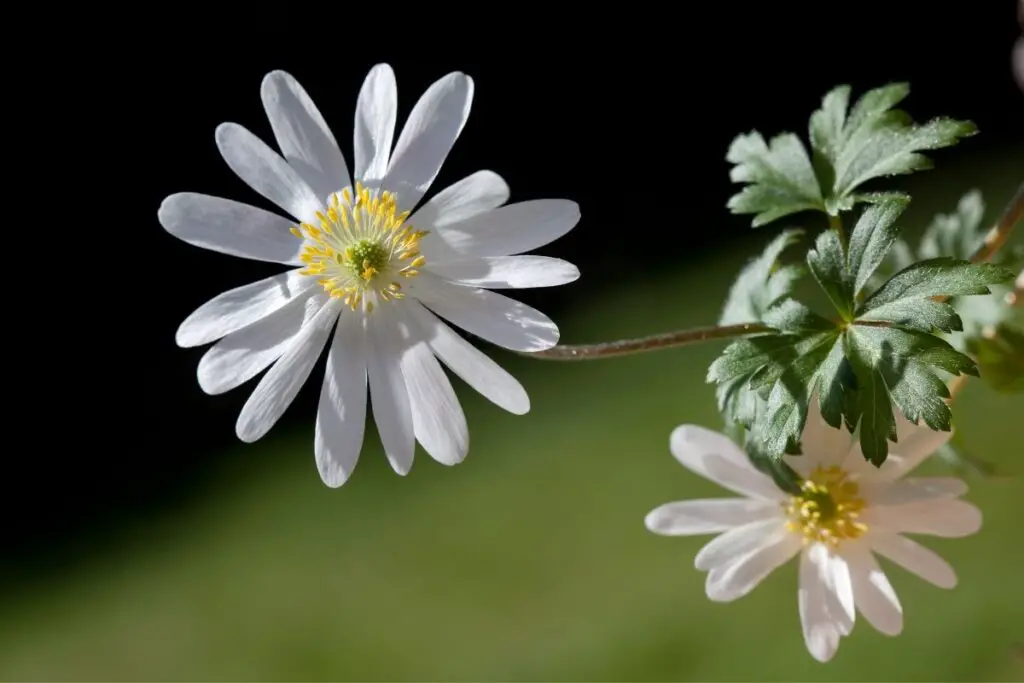
Snowdrops are excellent perennials that bear low green leaves and white-colored flowers. They are drought-resistant. So, your tulip bulbs will be safe from getting rot.
When your tulip foliage dies and turns yellow, its leaves remain green. As both Tulips and Snowdrops have the same colored leaves, they can camouflage the dying tulip leaves and will still make your garden green.
Snowdrops will require filtered sun, well-drained, and sandy soil for good spreading.
You can plant them in front of the tulips. For they require partial shade, the tall tulips behind them will save them from the direct sunlight.
As they bloom during the late spring or early summer, your garden will still have these white flowers after the tulips die.
Hyacinths
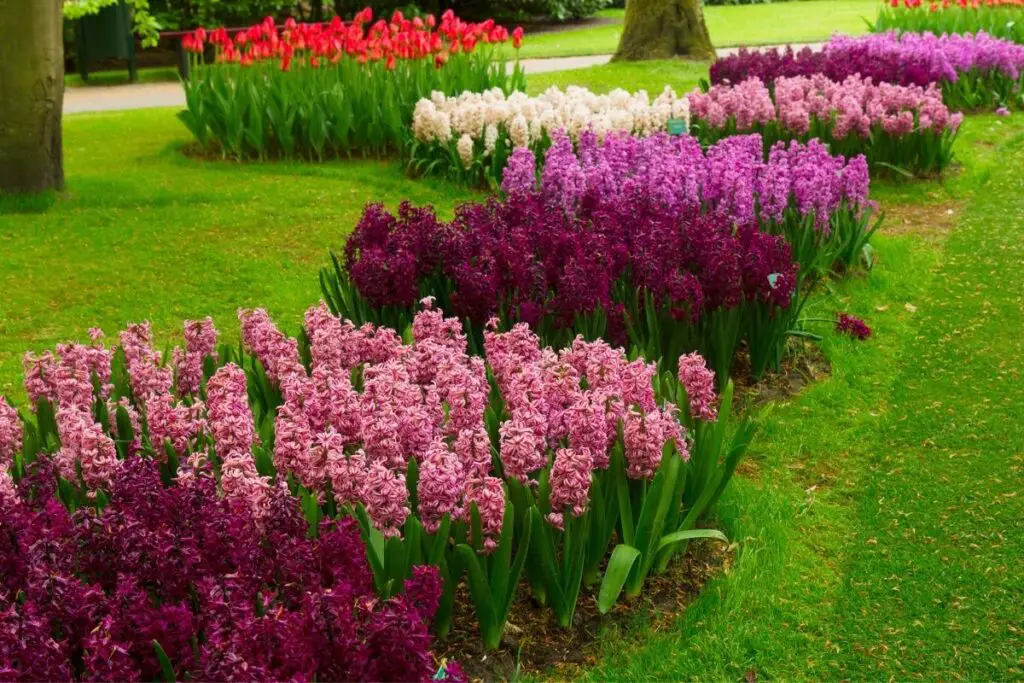
Grape Hyacinth is another flowering plant that blooms during the early spring.
They need well-drained soil and a location where they can receive plenty of sunlight. The exact requirement goes for tulips. Just like the Tulips, they need 1-inch of water per week.
They look delightful when paired with Tulips. Their tiny flowers will decorate the landscape when planted in between the Tulips. They will return each year during the spring.
Giant Hyacinths can also be paired with big wide Tulips. Growing Hyacinths with tulips will encourage good pollination in both plants.
Crocus
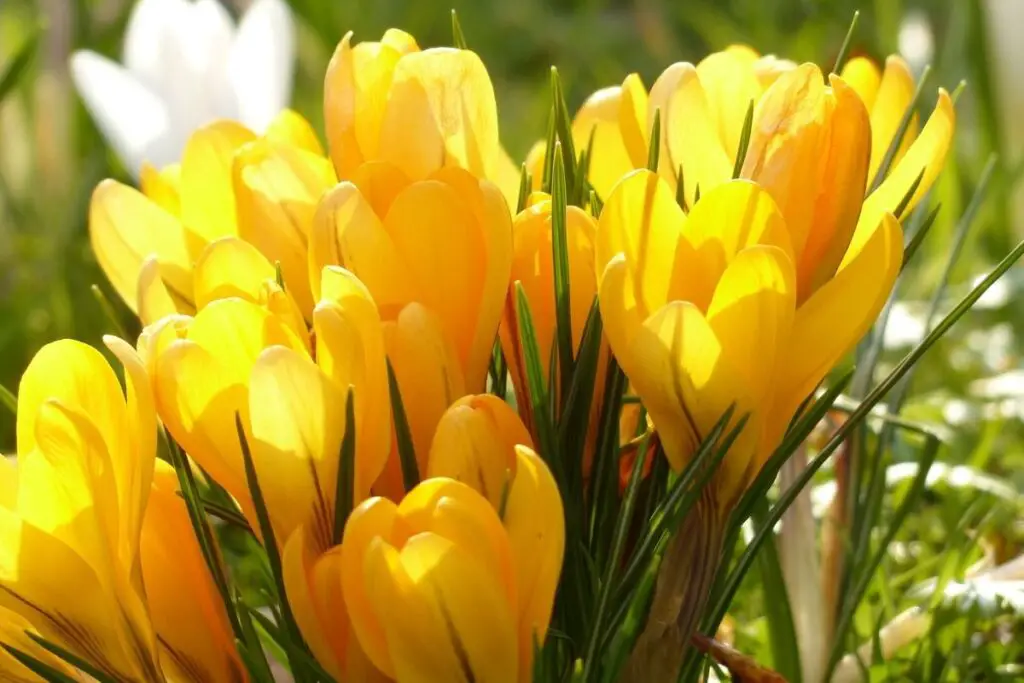
These are bulb plants like the tulips. But their bulbs are smaller in size than the Tulips. Still, you can plant them in the same soil bed.
They enjoy full sun and well-drained soil, just like the tulips. Like the tulips, Crocuses need to be fertilized once or twice a year.
Crocuses bloom during the early spring, just when the tulips flower. You can say that the Crocus blooming just before the tulips are a preview version for tulips.
One merit of growing crocus with tulips is more pollinators. Tulips have a low amount of nectar. So pollinators might not get interested in your garden.
But, with Crocus, they would love to visit your garden frequently. Crocus has a lot of nectar and pollen.
You can grow late-spring Crocus bloomers that will remain blooming beside the tulips when the latter is about to die. This will create a beautiful layering look in your garden.
Your garden will not look empty after tulips die.
Daffodils
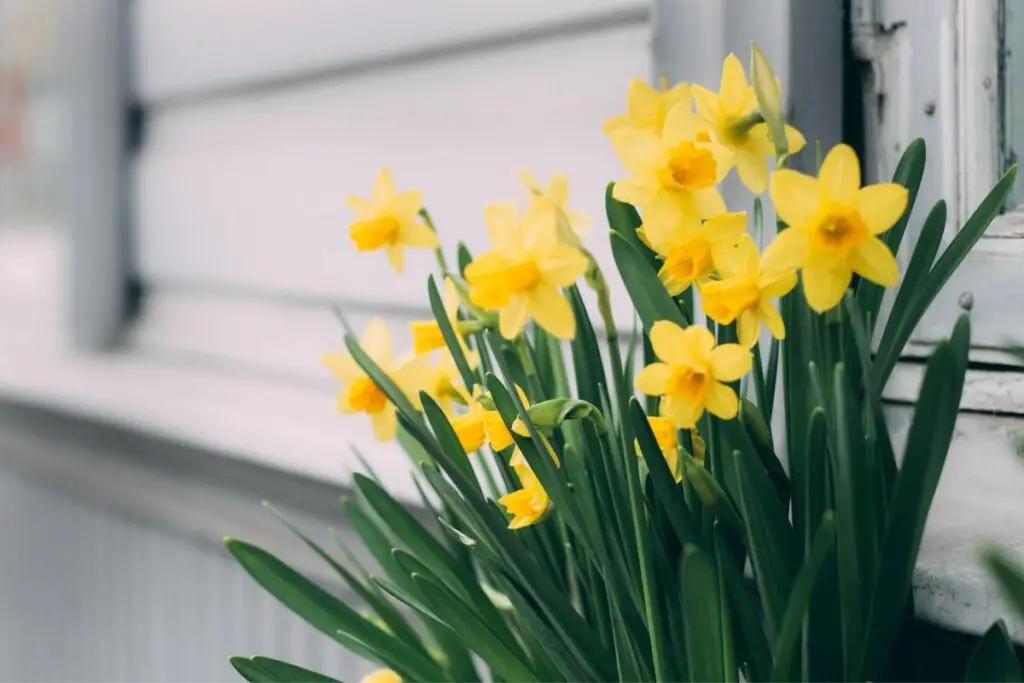
Another perennial that blooms during the spring are Daffodils. Planting these bulbs in the fall besides Tulips will give your garden an outburst of color in spring.
Both are low-maintenance plants. Trumpet shapes with yellow and white colors, Daffodils will perfectly match tulips as contrasting hues.
They demand full sun to partial shade and well-drained soil. Planting Daffodils with Tulips has beneficial merit. Daffodils are pest-resistant.
Growing these two flowers side by side will save your tulips from getting attacked by any pests.
Both will need deadheading after they finish blooms. As both are bulbs and both of their flower and leaves dying times are the same, you can do it simultaneously.
You don’t have to bring out extra time separately for deadheading them.
Daylilies
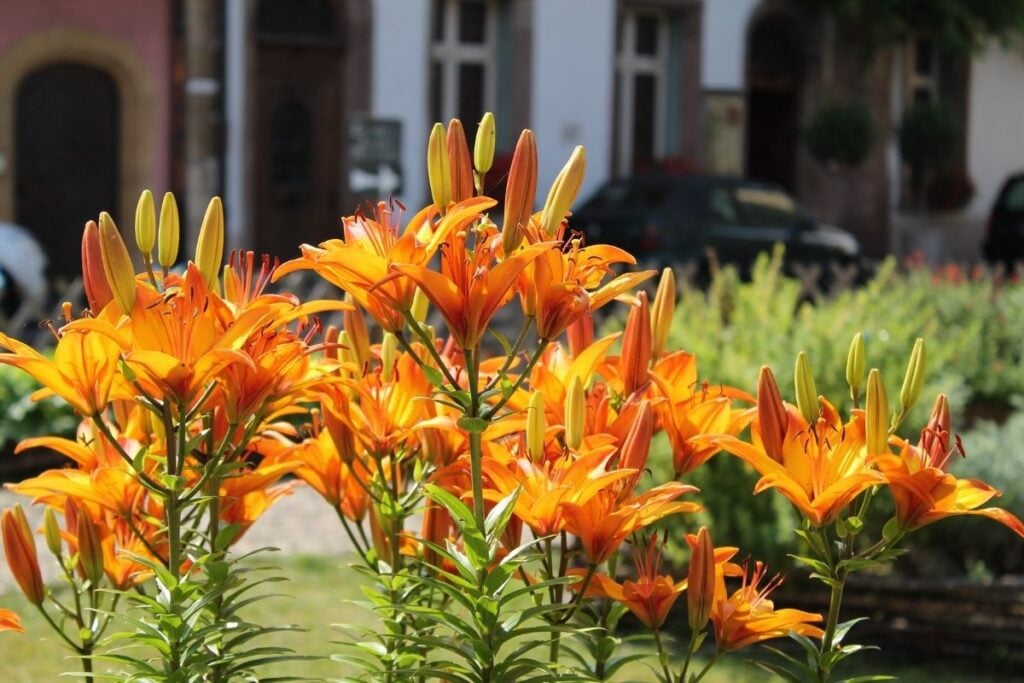
Daylilies will follow the blooming cycle of the tulips and will still keep your garden filled with some flowers when the tulips die. Their bright green leaves and colorful blooms will cover the tulips’ faded blooms and dead leaves.
Daylilies keep blooming for years, one after another. Just like Tulips, you can plant the bulbs in the fall in a location where they can get plenty of sunlight. They would enjoy growing in well-drained and evenly moist soil.
They are an ideal companion for tulips because of their blooms after the Tulips die and their leaves, which resemble the tulip foliage. Nobody’s attention will fall much over the dead tulip leaves.
Though Daylilies can resist pests, they are prone to Daylily disease, a kind of rust.
Bleeding heart
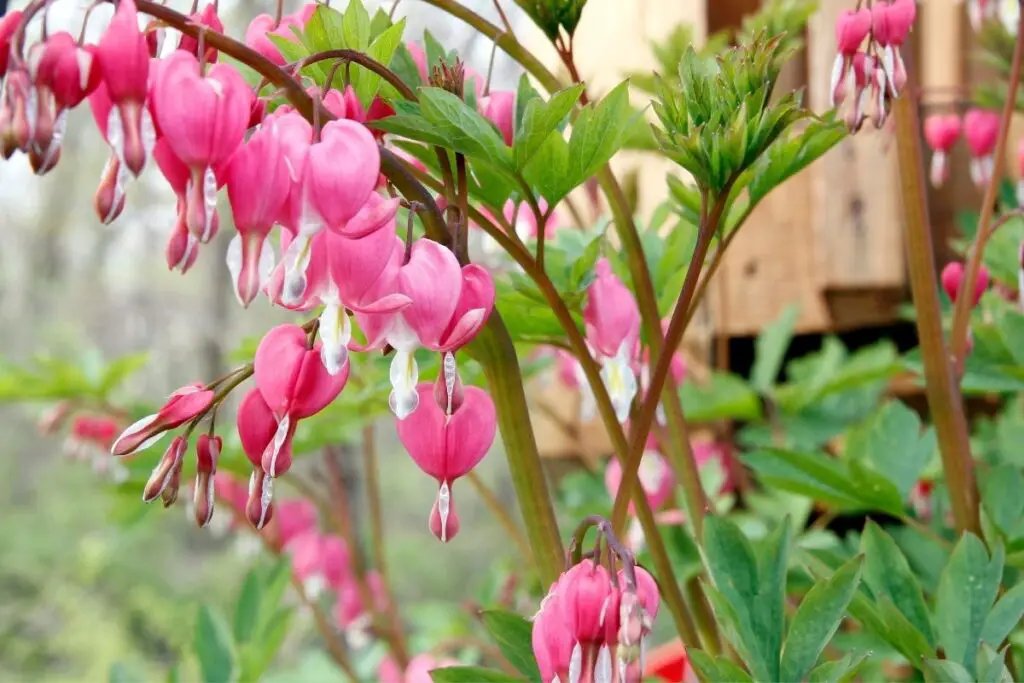
Bleeding hearts are an ideal choice of tulip companion because of their color and shape.
As the name suggests, the flower resembles the shape of a heart and beautiful deep pink color. They have got 2 rose-pink outer petals and 2 white inner petals.
The Bleeding heart flowers grow upside down. They have a stamen that comes out from the bottom of the flower. From far enough, they look like a bleeding heart.
Like the Tulips, the Bleeding heart enjoys growing in evenly moist soil. You can add mulch to help the plants absorb excess water and retain moisture.
When the mulch breaks down into the soil, the soil bed will turn fertile. Both the flowers will love standing over fertile soil.
Two good points about this flower are that they don’t need deadheading and will resist pests. So your Tulips are safe from deer and rodents.
However, they are not an ideal choice for tulips because they die in summer. Due to this, they won’t cover up the faded and dead Tulips. But because of their shape and color, growing them with Tulips will make your garden extraordinary.
Red hebe
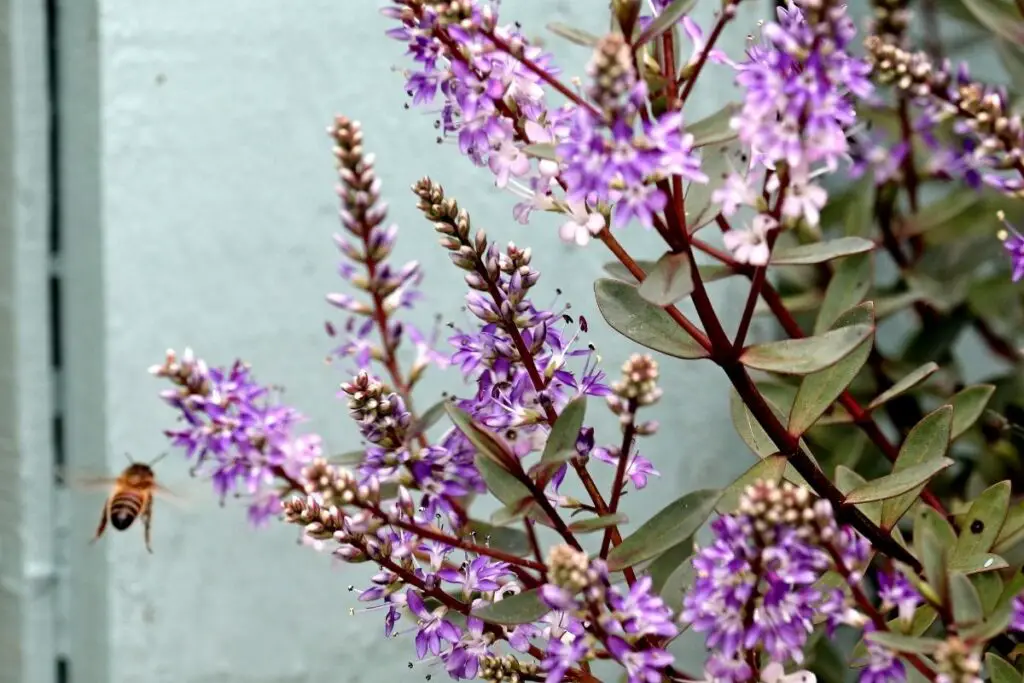
Hebes are the shrub plants that will look good with some red Tulips. They share the exact requirements as the tulips – full sun, well-drained, and fertile soil.
When grown with tulips, Red hebe can create a suitable backdrop, giving your garden a better appearance along with the color and shape of the Tulips.
Honesty
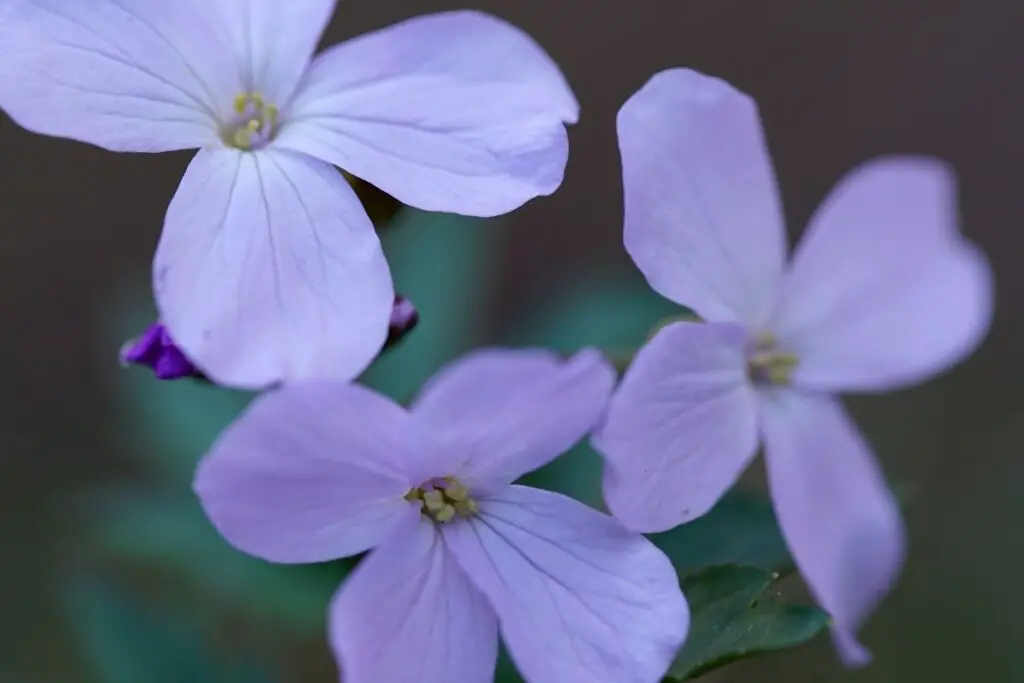
These flowers would thrive under a sunny spot, well-drained and consistently moist soil, and they will get themselves adapted to any pH level. This makes them ideal for Tulips.
Honesty flowers will make a distinctive color contrast when grown with Tulips, significantly when the white and purple flowers are grown with the Queen of Night Tulips.
The Honesty flowers will look amazing with these bold purple Tulips when they naturalize.
Sage
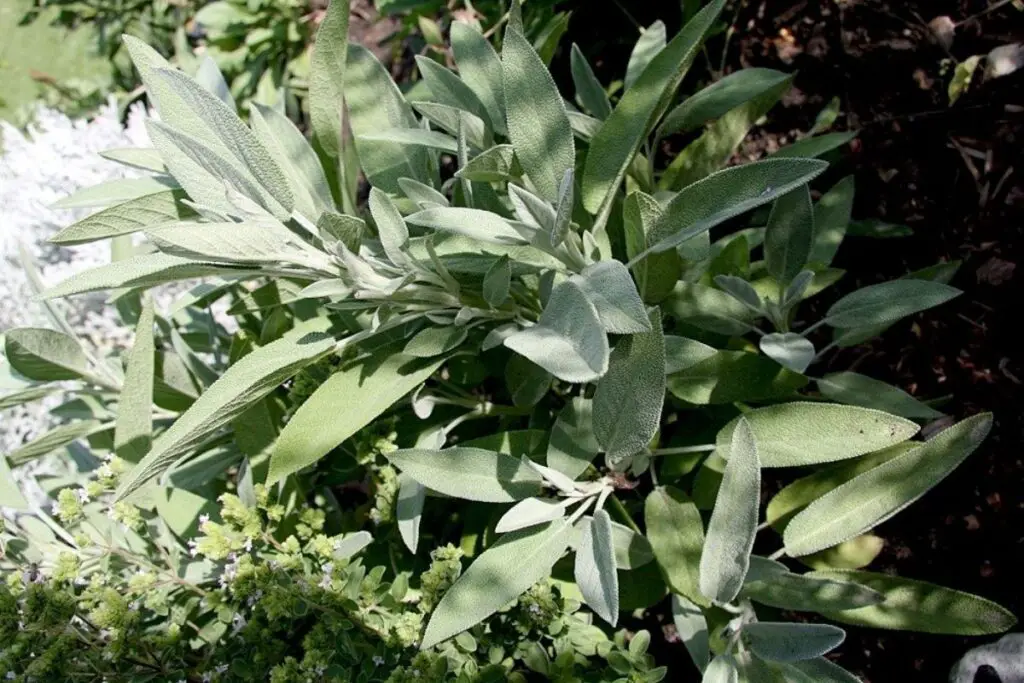
Generally, Sage is a herb found in most houses and gardens as well. They are known for their healing and repelling talents.
Sage will create a wonderful setting for tulips because of their pretty blue to purple colored flowers and green leaves.
When the tulip flowers and leaves die, the green leaves of the Sage will tend to make your garden neat and clean instead of looking dull and famishing. They will flower in the summer.
So, when your Tulips die in spring, sage flowers will keep your garden blooming.
They would grow in a sheltered place, under full sun in moist but well-drained soil. You also don’t have to worry about watering them. Both of them will like being in slightly acidic soil to neutral.
Though Sage likes neutral soil, the slight acidic form ideal for tulips won’t harm them much.
They are drought-tolerant plants but will need water until they become established enough. So, when you water the Tulips once a week in their growing season, you can water them too to keep them moist.
Another advantage of growing Sage with tulips is pest resistance. The pests and insects will hate the smell in the Sage. So, your Tulips will be safe from all kinds of pests.
Columbine
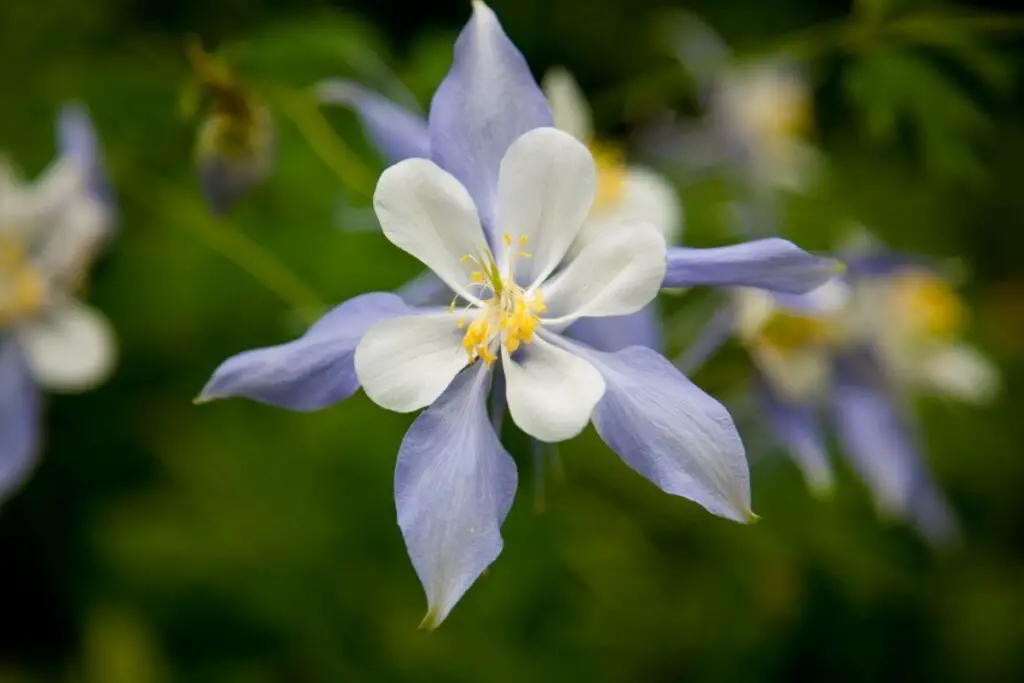
Columbine is a hardy perennial originating from America. They, too, are low-maintenance plants like the tulips and need deadheading. They are a perfect companion for tulips due to their matching features and color contrast with tulips.
Columbine has various shades. They are like bell-shaped and spurred flowers. They contain a lot of colors like bright reds, yellows, oranges, purples, and color combinations.
They need full sun, neutral soil, evenly moist, well-drained soil, just like the Tulips. After you plant Columbine in the early fall, right after that, you will need to plant the bulbs. Both of them will flower in spring.
But when the Tulips die after spring, the Columbine will flower till summer. So your garden will be having these beautiful Columbines after Tulips.
Adding a layer of mulch in the soil bed will work equally well for both. The mulch will improve drainage and, after breaking down, will make the soil fertile, which both Columbine and Tulips will enjoy.
Coneflowers
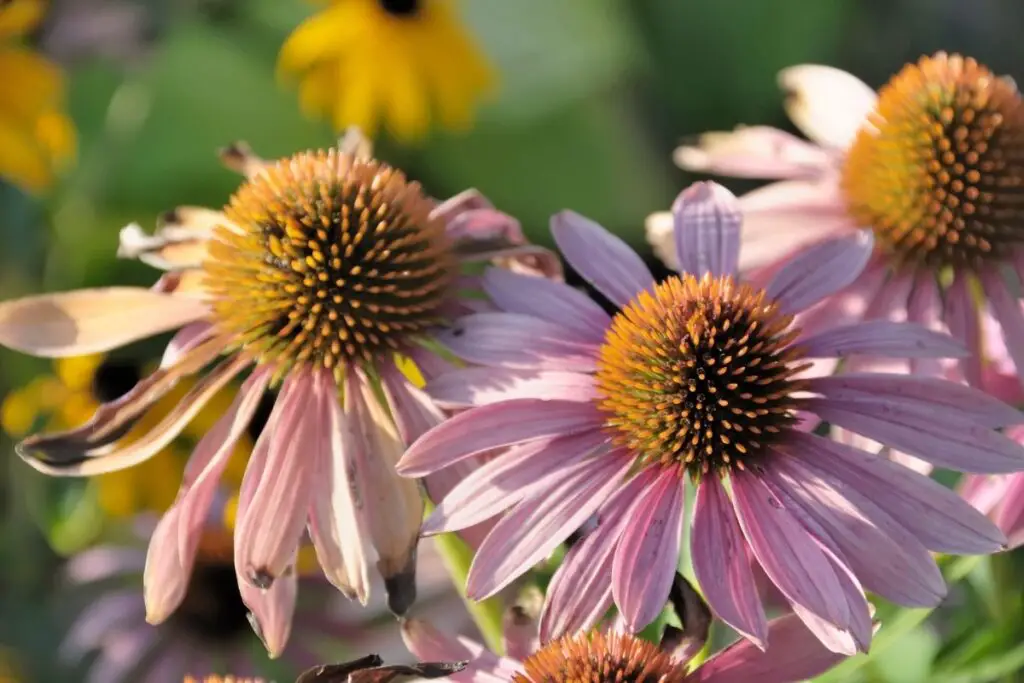
Coneflowers will grow well when planted in full sun, well-drained soil with a layer of mulch or compost, and watered with 1-inch water once a week. This applies the same to the Tulips. So growing Tulips and Coneflowers side by side is easy.
When the spring ends, the tulip blooms will die, and after a few weeks, the foliage too will turn yellow and die. But, Coneflowers will remain blooming because they flower the whole summer.
When the Tulips fade, Coneflowers will keep your garden filled with blooms after spring.
They are a great companion for Tulips because of their growing conditions, which are the same as tulips, and their blooming time, which helps the garden look dull after tulips die.
Violas (Violet)
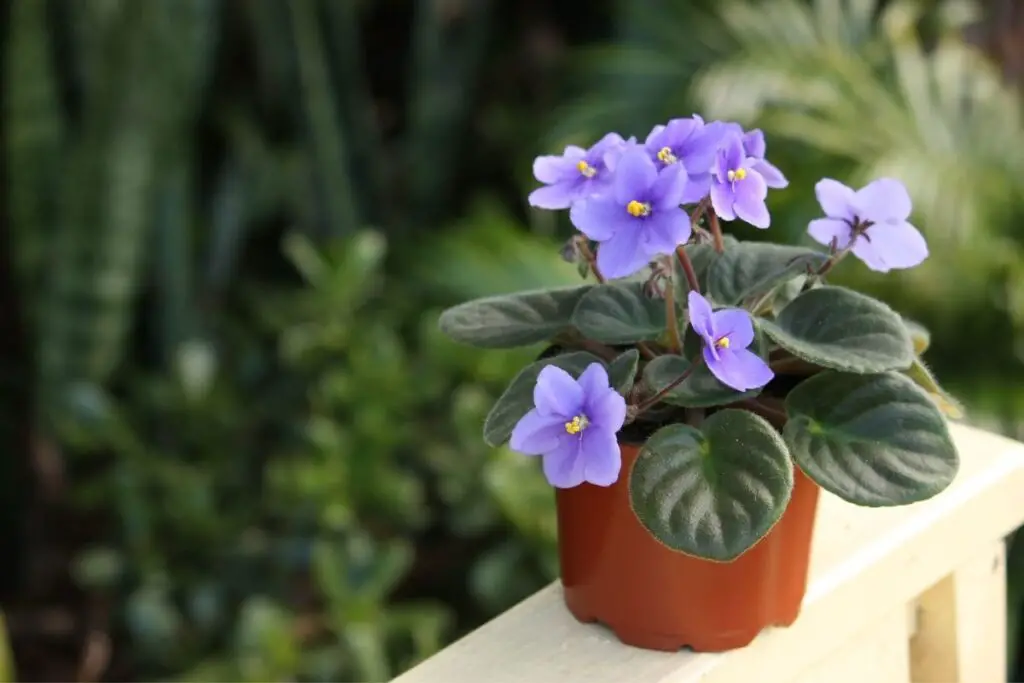
Violas are beautiful groundcover flowers bearing green leaves and striking blooms. Violas will remain healthy when grown in moist and well-drained soil, occasional trimming, deadheading, and receiving full sun.
Other than trimming and deadheading, other requirements are the exact as Tulips. However, Tulips also need deadheading when the flowers fade.
Violas and Tulips have more or less the same blooming season, which is spring. Violas tend to flower also during the fall.
One advantage of growing Violas with Tulips is that the former will help to attract more pollinators to the garden. Tulips have very little nectar. So pollinators might visit your garden.
There are a lot of other plants which can be grown along with tulips:
- Bluebells
- Wallflowers
- Bronze Fennels
- Pansies
- Hellebore
- Ornamental Grass
- Asiatic Hybrid Lilies
- Veronica
- Dianthus and many more.
If you don’t want to plant the plants I have discussed, you can try these too.
Final thoughts
All the companion plants of Tulips I have discussed above have more or less identical kinds of requirements. So, you will have to put very little or no effort into looking after them.
As I mentioned earlier, there are a lot of other plants you can plant with Tulips. Instead of keeping the Tulips lonely, adding other plants will give them a companion and make your garden look bright, vibrant, and stunning. Enjoy gardening!
Source: Wikipedia, North Dakota Stae University, The Royal Horticultural Society.
